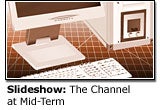As the channel enters the back half of 2007, there is a remarkable sense of calm pervading the community largely as the result of the convergence of several external rather than internal forces.
The main sense of calm comes from the fact that the economy is continuing to grow, with the fastest amount of growth taking place in the small and midsize business sector where the channel just happens to be strongest.
Overall technology sales in the SMB sector for the three-month period ending in June have grown 9.4 percent, according to a report authored by Raymond James analyst Brian Alexander.
In general, sales for large resellers serving corporate, SMB and government sectors grew 8 percent. Much of that activity seems to be benefiting North American distributors, who the report says have seen about 3.9 percent rise in shipments.
Sometimes it’s not enough to have a good, strong economic headwind at your back. Sometimes your rival needs to make some significant missteps. Such is the case with long-time channel nemesis Dell, which for the past few months has been noticeably less aggressive on pricing as it tries to right its own internal profit picture against a sea of mounting accounting problems. The end result is that the average selling prices for desktop and notebook systems are holding steady. Alexander attributes some of this to the Dell situation, but notes that customers may be future-proofing systems by buying configurations today that can support upgrades to Vista at a later date.

Finally, Alexander notes a third factor affecting demand in the market place that often goes unnoticed: a strong refresh rate for systems and networking gear, in part an echo of the echo effect from the Year 2000 upgrades we saw at the beginning of the decade. The first echo of that massive refresh took place in and around 2004 and now we’re beginning to see a lot of that 2004 equipment be refreshed in 2007. According to the most recently released data from the NPD Group, the fastest growing product sales areas in the channel are storage, PC memory, desktop computers and notebooks.
All this activity now has every vendor, including Dell, tripping over themselves to shore up their indirect sales strategies, which means solution providers are probably receiving more attention from more vendors than any time in recent memory.
The thing to be on guard against, however, is complacency. The channel made a tremendous amount of progress on the road to self sufficiency by embracing services at a time when pricing was under pressure and every tin hat analyst on Wall Street was saying the indirect sales model was all but dead. Now prices are holding and the channel is everyone’s darling again. While all that is good, it can quickly lead to over-dependency on vendor product margins rather than high protein services revenue that makes each solution provider steward over their own capitalistic enterprise, as opposed to being the downstream recipient of a welfare state system dictated over by the political winds of the day emanating from Wall Street and the vendor community at large.
